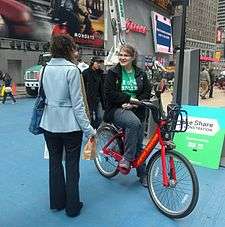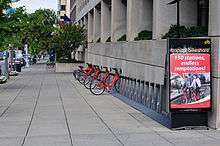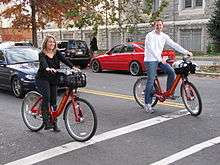Capital Bikeshare
Capital Bikeshare (also abbreviated CaBi) is a bicycle sharing system that serves Washington, D.C.; Arlington County, Virginia; the cities of Alexandria, Virginia and Falls Church, Virginia; Montgomery County, Maryland and Fairfax County, Virginia. As of August 2019, it had 579 stations and 4,981 bicycles, all owned by these local governments and operated by contractor Motivate International.[4] Opened in September 2010, the system was the largest bike sharing service in the United States[5] until New York City's Citi Bike began operations in May 2013.[6]
 | |
| Overview | |
|---|---|
| Owner | Alexandria, Arlington, District of Columbia, Fairfax County, Falls Church City, Montgomery County, Prince Georges County |
| Area served | Alexandria, Virginia; Arlington, Virginia; Fairfax County, Virginia; Falls Church City, Virginia; Montgomery County, Maryland; Prince Georges County, Maryland; Washington, D.C. |
| Locale | Washington metropolitan area |
| Transit type | Bicycle sharing system |
| Number of stations | 579[1] |
| Daily ridership | 9,322+[2] |
| Annual ridership | 3.4 million+ |
| Website | www |
| Operation | |
| Began operation | 2010 |
| Operator(s) | Motivate |
| Number of vehicles | 4,981+[3] |
History
Genesis

The SmartBike DC bike sharing service, a predecessor to Capital Bikeshare, debuted in 2008 with 10 stations and 120 bicycles.[7] It was the first of its kind in the United States.[8] D.C. Department of Transportation Director Gabe Klein came into office four months later and was eager to expand it, but found the private partner had a "lackluster commitment."[9] Because the agreement specifically prohibited DDOT from paying for anything related to SmartBike, an expansion required DDOT to renegotiate the contract.[9] But in his first meeting with Clear Channel he found that Clear Channel believed they had gotten a bad deal on the original contract that created SmartBike; that following their purchase by Bain Capital they were no longer interested in "municipal street furniture" and that they had neither desire nor obligation to expand the program. In addition, it was difficult and expensive to install new stations, because they required the local utility company to bring electricity to each station.[10] As a result, Klein chose to end the program and instead work with Arlington County, Virginia, to build a new, regional bikesharing program to be called Capital Bikeshare.[11]
Capital Bikeshare was to be owned by the local governments and operated by a private operator. Alta Bike Share received the operations contract.[4] Planning and implementation costs for the new system totaled $5 million.
Launch
The new service launched in September 2010 with 400 bicycles at 49 stations.[12][13] Shortly thereafter, in January 2011, SmartBike DC ceased operations.[14]
Planning and implementation costs for Capital Bikeshare totaled $5 million, with additional first-year operating costs of US$2.3 million for 100 stations.[15] The District's share of planning, implementation and first-year operating costs was partially financed by a $6 million grant by the United States Department of Transportation. Arlington County's operating cost share of the plan was $835,000 for the first year, funded by public contributions including a grant from the Virginia Department of Rail and Public Transportation as well as subsidies from Arlington County Transportation, Crystal City Business Improvement District, and the Potomac Yard Transportation Management Association. In April 2011, Capital Bikeshare administrators said they expect earned revenue to cover 50% of the system's annual operating costs.[16] The District of Columbia also planned to sell advertising on Capital Bikeshare stations with the goal of raising US$500,000.[17]
By February 2011, Capital Bikeshare had expanded to 100 stations in the District of Columbia and 14 stations in the Pentagon City, Potomac Yard, and Crystal City neighborhoods in Arlington.[5] In April 2011, it had 11,000 members and 1,100 bikes in circulation.[18] In September 2011, Capital Bikeshare announced it had reached 18,000 members and one million rides in its first year of operation, doubling initial expectations.[19] During the summer of 2013, riders averaged almost 300,000 rides per month. That means that during the peak season, each bike was being used about four times per day. Throughout 2013, users traveled almost 2.5 million miles and burned 100 million calories. The average weekly savings was calculated as $15.39; the total annual savings for the roughly 24,000 members was about $370,000.[20]
The National Park Service originally prohibited Capital Bikeshare stations on the property it manages, including large areas such as the National Mall. However, the agency later reversed itself and said that it would work to include new stations in future expansions.[21] The first two of five approved Capital Bikeshare stations opened on the National Mall on March 16, 2012, shortly before the start of the 2012 National Cherry Blossom Festival.[22]
In 2010, an unlisted Bikeshare station was installed on the White House grounds, inaccessible to the public.[23] It was removed in August 2017 at the request of the Trump Administration.[24]
Also in March 2012, the Arlington County government gave away 550 red Capital Bikeshare helmets and twice as many flashing safety lights as part of a promotion.[25]
Expansion

Capital Bikeshare has grown steadily, which has driven demand for more stations and bikes. Transportation agencies in each jurisdiction select the location of the rental stations, as well as the number of bike docks, depending on planners' estimates of local demand.[26] Most of the system's users live in or near the city center; stations in the poorer eastern portion of the city are comparatively underused.[10]

In 2010, a local transportation official said that the system could be expanded further throughout the D.C. area and have as many as 5,000 bicycles within a few years.[27]
In fall 2011, the District Department of Transportation announced plans to add 32 stations and expand 18 existing ones by year's end,[28] then add 50 more in 2012.[29]
Arlington County also announced plans to add 30 stations in fall 2011, primarily along the densely populated corridor between the Rosslyn and Ballston neighborhoods, and 30 more in 2012.[30]
In October 2011, the neighboring city of Alexandria, Virginia, approved plans to deploy 54 bicycles at six stations in the Old Town and Carlyle neighborhoods in 2012, then add six more stations in 2013. The cost of the first year would be $400,000, including operating costs of $100,440.[30][31] The first eight Alexandria stations were deployed in August 2012.
Montgomery County, Maryland, similarly approved plans to install 20 stations and 200 bikes in the Rockville and Shady Grove areas near Washington Metro stations and high-traffic destinations such as Montgomery College and Rockville Town Center. The expansion will be paid for by a $1.288 million grant from the National Capital Region Transportation Planning Board with a $688,000 local match.[32] Officials also cited plans to add 50 stations and 400 bicycles in southern areas of the county, including Bethesda, Silver Spring, Friendship Heights, and Takoma Park.[33] However, bicycling advocates cautioned that clusters of stations in the county could be too far from each other as well as the larger network of stations within neighboring Washington, D.C. There was also concern that the county has too few bike lanes and trails to support the expected number of users.[34] Despite these concerns, Montgomery County added its first stations in May 2013.
By September 2012, these additions and expansions were to have brought the network to 288 stations and 2,800 bikes in four jurisdictions.[30]
In 2014, plans to add about 60 stations were put on hold after CaBi's main source for the bikes, the Montreal-based Public Bike System Co., went bankrupt. Over the next year, Capital Bikeshare bought used bikes and docks from the Ottawa bikeshare system, and new bikes from Motivate, a "New York-based company formed by investors who purchased previous operator Alta Bicycle Share." The expansion resumed in late 2015.[35] In August 2015, Capital Bikeshare announced that it had found a new equipment supplier and would add 435 bikes and 40 stations in D.C. and 140 bikes and 20 stations elsewhere. It also reported having 29,000 members who had taken a total of more than 10.5 million trips.[36][36]
On September 1, 2016, the system celebrated the installation of its 400th station at Division Ave & Foote St NE in Washington, DC.[37] On October 21, 2016, Fairfax County, Virginia deployed 29 stations and 212 bikes in the Reston and Tysons Corner areas.[38]
On June 1, 2018, Capital Bikeshare expanded its territory for bike rentals, establishing itself in Prince George’s County, which became the sixth jurisdiction to join the system.[39][40] An official ceremony kicking off the service was held on June 1.[41] Stations are located in Largo and Hyattsville with an expansion planned along the Route 1 corridor and National Harbor.
In September 2018, Capital Bikeshare offered e-bike as pilot, Capital Bikeshare Plus, but brake problems ended the pilot on April 14, 2019.
In May 2019, 11 new stations were added in the seventh member jurisdiction, Falls Church, Virginia.Link
Technology
Capital Bikeshare uses the BIXI-branded system provided by Montreal-based PBSC Urban Solutions.[27] The platform behind the bike share system is created by 8D Technologies, who also supply the server technology for BIXI Montréal, Citi Bike in New York City, Santander Cycles in London, and others.
Rental stations are automated and powered by solar panels, allowing them to be located anywhere space is available. A wireless data link connects the docks and station kiosk to a central bike-tracking and billing database.[42] Riders can use the Capital Bikeshare website and smartphone applications to see where rental stations are located and how many bikes and empty docks they have.[12]
Each bike dock has a repair button; users press this to report a damaged or malfunctioning bike and take it out of service. Riders are expected to notify Capital Bikeshare if a bike is unable to dock at a station and are responsible for the rented bike until it has been returned.[43]
The red-colored aluminum unisex bicycles have three gears, an adjustable seat, and a front basket as well as a headlight and twin red taillights that are powered whenever the bicycle is in motion.[44]
Unlike some other networks, Capital Bikeshare maintains service year-round except during severe weather.[45]
While all seven member jurisdictions own the physical infrastructure (bikes and docks), operations are handled by Motivate which has been owned by Lyft since 2018.[46]
In May 2011, it cost $41,500 to install a station with six docks and $49,300 each for larger stations with 14 docks. Each bicycle cost about $1,000, and the annual operating cost per bike was $1,860.[31]
Pricing

As of July 2016, Capital Bikeshare has two payment options: swiping a credit card at a dock or signing up online. At any dock, riders may purchase a single trip ($2), a 24-hour pass ($8), or a 3-day pass ($17), swiping a credit card at the station's kiosk to receive a code to unlock a bike. Online, riders may purchase passes for a month ($28) or a year ($85 if paid in one lump; $96 if paid in monthly increments of $8);[47] these riders are mailed an RFID key that can unlock bikes without a code, or can pick their key up at select docking stations.[48]
Any rider may take unlimited trips of up to 30 minutes, measured from when the bike is withdrawn from a dock to when it is returned. (If a destination station is full, riders can use the kiosk to get 15 more free minutes to return the bike to another location.[43]) Longer trips incur fees for each additional half-hour on a scale that rises from $1.50 to $8.00. These prices are designed to encourage short trips from place to place instead of longer leisure rides.[44][49]
A replacement fee of $1,000 is charged to the credit card on file if a rented bike is not returned within 24 hours.[44]
The one-trip fare was introduced in June 2016 during WMATA's SafeTrack program, which would shut down segments of the Washington Metro for the following year.[50]
See also
References
- https://opendata.dc.gov/datasets/capital-bike-share-locations
- "CaBi Dashboard". Capital Bikeshare. Retrieved August 19, 2012.
- Jordan, Pascale (August 15, 2019). "These Are All The Vehicles You Can Rent Via App In The D.C. Region — And Some You Can't". WAMU. Retrieved September 22, 2019.
- "Capital Bikeshare". Alta Bike Share, Inc. Archived from the original on November 3, 2013. Retrieved November 19, 2013.
- Martinez, Matt (September 20, 2010). "Washington, D.C., launches the nation's largest bike share program". Grist. Retrieved April 14, 2011.
- Flegenheimer, Matt (May 27, 2013). "Out for a First Spin: City's Bike Share Program Begins". The New York Times. ISSN 0362-4331. Retrieved June 8, 2013.
- Shaheen, Susan; Guzman, S.; H. Zhang (2010). "Bikesharing in Europe, the Americas, and Asia: Past, Present, and Future" (PDF). Transportation Research Board. Archived from the original (PDF) on June 10, 2012.
- Silverman, Elissa (April 19, 2008). "Bicycle-Sharing Program to Debut". The Washington Post. Retrieved August 16, 2011.
- Klein, Gabe (October 19, 2015). "How Washington, D.C.'s Broken Bikeshare Program Became a National Leader". Government Technology. Retrieved September 22, 2019.
- DePillis, Lydia (April 14, 2011). "Bikesharing is Bikecaring". Washington City Paper. Retrieved April 14, 2011.
- Klein, Gabe; Vega-Barachowitz, David (October 15, 2015). Start-Up City: Inspiring Private and Public Entrepreneurship, Getting Projects Done, and Having Fun. Washington, DC: Island Press. p. 149. ISBN 9781610916905.
- J. David Goodman (September 20, 2010). "Bike Sharing Expands in Washington". New York Times. Retrieved April 14, 2011.
- Halsey III, Ashley (September 21, 2010). "New Bikeshare program provides wheels to casual cyclists in D.C., Arlington". The Washington Post. Retrieved May 13, 2016.
- Rosiak, Luke (December 17, 2010). "Sun sets on SmartBikeDC". The Washington Post. Retrieved April 14, 2011.
- Kaplan, Melanie D.G. (November 15, 2010). "D.C. unveils country's largest bike share program". SmartMoney.com. Archived from the original on January 6, 2011. Retrieved April 9, 2011.
- "Capital Bikeshare, Largest Bikeshare Program in the United States". September 20, 2010. Retrieved April 9, 2011.
- Neibauer, Michael (April 7, 2011). "D.C. eyes bike share advertising". Washington Business Journal. Retrieved April 15, 2011.
- Benfield, Kaid (April 27, 2011). "Washington, D.C.: Making Bike Commutes Cool". The Atlantic. Retrieved September 22, 2019.
- "Capital Bikeshare Hits One Million Rides on First Anniversary". Capital Bikeshare. September 20, 2011. Retrieved October 17, 2011.
- Johnston, Kristine (April 7, 2014). "Beyond Urban Planning: The Economics of Capital Bikeshare". Georgetown Public Policy Review.
- Craig, Tim (September 6, 2011). "Capital Bikeshare coming to Mall". The Washington Post. Retrieved October 17, 2011.
- Berman, Mark (March 16, 2012). "Capital Bikeshare stations open on the Mall". Post Local: Dr. Gridlock. The Washington Post. Retrieved June 6, 2012.
- Cranor, David (November 26, 2010). "White House has a "secret" CaBi station". ggwash.org. Retrieved August 16, 2017.
There is one Capital Bikeshare station that doesn’t show up on the online map: the White House station. Located just inside the gate on State Place at 17th St, NW the station can only be used by those who can actually get inside the White House’s security perimeter.
- Freed, Benjamin (August 16, 2017). "Trump Removed the White House's Capital Bikeshare Station". Washingtonian. Retrieved September 22, 2019.
The station was removed earlier this week at the Trump Administration’s request, District Department of Transportation spokesperson Terry Owens tells Washingtonian.
- Berman, Mark (March 9, 2012). "Hundreds of Arlington residents grab free bike helmets". Dr. Gridlock. The Washington Post. Retrieved March 20, 2012.
- "DDOT Releases District Bikesharing Locations, Maps". MyFoxDC.com. July 20, 2010. Retrieved April 14, 2011.
- Goodman, Christy (May 23, 2010). "Expanded bike-sharing program to link D.C., Arlington". The Washington Post. Retrieved February 23, 2011.
- "DDOT Press Release: DDOT Announces 32 New Capital Bikeshare Stations in the District" (Press release). District Department of Transportation. Archived from the original on September 19, 2011. Retrieved February 5, 2019.
- "DDOT DC". @DDOTDC. September 22, 2011. Retrieved March 27, 2012.
- "Arlington votes (sort of) to expand CaBi; more places likely to follow". TheWashCycle. October 17, 2011. Retrieved September 22, 2019.
- Michael Lee Pope (May 11, 2011). "BikeShare Under Consideration" (PDF). Alexandria Gazette Packet. Retrieved August 4, 2015.
- "CaBi coming to Rockville and Shady Grove". TheWashCycle. Retrieved October 17, 2011.
- Billing, Greg (November 30, 2011). "Bikesharing Growing to Montgomery County". Washington Area Bicyclists Association. Retrieved December 10, 2011.
- "Bikesharing is coming – but where is the infrastructure?". Silver Spring Trails. Archived from the original on April 30, 2012. Retrieved December 10, 2011.
- "BikeShare Purchases". August 4, 2015. Retrieved August 4, 2015.
- Lazo, Luz (August 3, 2015). "Capital Bikeshare to get new bicycles, add nearly 60 stations starting this fall". Washington Post. Retrieved January 27, 2016.
- Giambrone, Andrew (September 2, 2016). "Bikeshare Riders Aren't Good at Selfies". Retrieved October 21, 2016.
- Lefrak, Mikaela (October 17, 2016). "Capital Bikeshare Expanding To Tysons Corner, Reston". Retrieved October 21, 2016.
- "And Then There Were Six". Retrieved May 18, 2020.
- Lazo, Luz (May 8, 2018). "Capital Bikeshare rolling into Prince George's County". The Washington Post. Retrieved March 25, 2020.
- "Capital Bikeshare Comes to Prince George's County". Retrieved March 25, 2020.
- "BIXI System". Public Bike System Company. Archived from the original on February 9, 2010. Retrieved February 26, 2011.
- "Frequently Asked Questions". Capital Bikeshare. Retrieved April 14, 2011.
- Ashley Halsey III (September 21, 2010). "New Bikeshare program provides wheels to casual cyclists in D.C., Arlington". Washington Post. Retrieved April 14, 2011.
- "Capital Bikeshare Boasts Near Record Ridership in February". Capital Bikeshare. Retrieved December 23, 2011.
- https://www.motivateco.com/bike-share-leader-motivate-announces-transformative-agreement-with-lyft-to-advance-the-future-of-urban-transportation/
- "Capital Bikeshare Pricing".
- "Get your key". Capital Bikeshare Help. Retrieved July 21, 2018.
- "Capital Bikeshare Pricing". Capital Bikeshare. Retrieved October 3, 2010.
- "New Single-Trip Fare, Service Enhancements for SafeTrack" (Press release). Capital Bike Share. June 1, 2016. Retrieved July 8, 2016.
External links
| Wikimedia Commons has media related to Capital Bikeshare. |